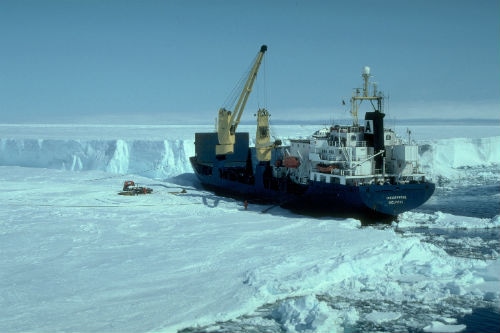May 21 2019
Ice sheets melting across the Antarctic and Greenland and the ensuing sea level rise (SLR) this creates, is generally acknowledged as a substantial threat to coastal communities and ecosystems.
 A German supply ship moored at the edge of an ice shelf in West Antarctica. The floating shelf extends for hundreds of miles inland and helps buttress the interior, grounded ice. (Image credit: Professor Jonathan Bamber, University of Bristol)
A German supply ship moored at the edge of an ice shelf in West Antarctica. The floating shelf extends for hundreds of miles inland and helps buttress the interior, grounded ice. (Image credit: Professor Jonathan Bamber, University of Bristol)
Approaches and measures to alleviate and plan for the possible impacts are dependent on scientific projections of future SLR – conventionally delivered using numerical modeling.
Such projections are still quite difficult because of the ongoing ambiguity regarding the evolution of the Antarctic and Greenland ice sheets, especially in response to climate change.
Using a method known as structured expert judgment (SEJ), an international team of researchers, headed by the University of Bristol, asked 22 ice sheet experts to estimate credible ranges for future sea level rise because of the projected melting of each of the Greenland, East Antarctic and West Antarctic ice sheets under low and high future universal temperature rise situations.
Their findings have been published recently in the journal Proceedings of the National Academy of Sciences of the United States of America.
SEJ provides a formal approach for estimating uncertain quantities based on current scientific understanding, and can be useful for estimating quantities that are difficult to model. Projections of total global SLR using this method yielded a small but meaningful probability of SLR exceeding two metres by the year 2100 under the high temperature scenario, roughly equivalent to ‘business as usual’, well above the ‘likely’ upper limit presented in the Fifth Assessment Report of the Intergovernmental Panel on Climate Change (IPCC).
Jonathan Bamber, Study Lead Author and Professor, School of Geographical Sciences, University of Bristol
The results indicate that coastal communities should thus not exclude the possibility of 21st-century SLR in excess of 2 m when preparing adaptation policies.
Professor Bamber added: “Such a rise in global sea level could result in land loss of 1.79 million km2, including critical regions of food production, and potential displacement of up to 187 million people. A SLR of this magnitude would clearly have profound consequences for humanity.”
The SEJ process offered an opportunity for specialists to deliberate over their scientific rationales for the quantitative judgments they make on reservations associated with future ice sheet contributions to sea level.
This unique method also helped to identify certain poorly assumed but potentially important processes, such as “marine ice cliff instability”, which may serve later as important tipping points in ice sheet response to temperature increase.
An important innovation in this research is the modeling of erratically determined dependences between the processes of accumulation, runoff, and discharge at each ice sheet – methods, say the study team, that they hope can be additionally developed and used in other areas of climate study.
It is hoped that the results can provide decision-makers with greater awareness of potential high-end SLR, which is crucial for robust decision making. Limiting attention to the ‘likely’ range, as was the case in the IPCC Fifth Assessment Report, may be misleading and will likely lead to a poor evaluation of the true risks.
Willy Aspinall, Study Co-Author and Professor, School of Earth Sciences, University of Bristol